Extensive Sills in the Continental Basement from Deep Seismic Reflection Profiling
Abstract
1. Introduction
2. Observations
2.1. Seismic Bright Spots and Magma in the Crust
2.2. “Frozen” Sills Detected by Reflection Surveys
2.2.1. Ground Truth: Siljan, Sweden
2.2.2. Identification via Outcrop
2.2.3. Extensive Sills in the Canadian Craton: Relicts of a Proterozoic Plume?
2.2.4. Basement Layering across the Central US: Fingerprints from the Keweenawan Plume?
2.2.5. Deep Sills and Ore Deposits—The Iberian Massif
2.2.6. Mantle Sills?
3. Discussion
4. Tectonic Implications
5. Conclusions
Author Contributions
Funding
Conflicts of Interest
References
- Bradley, J. Intrusion of major dolerite sills. Trans. R. Soc. 1965, 3, 27–55. [Google Scholar]
- Hargraves, R.B. Physics of Magmatic Processes; Princeton University Press: Princeton, NJ, USA, 1980; p. 565. [Google Scholar]
- Spence, D.A.; Turcotte, D.L. Magma-driven propagation of cracks. J. Geophys. Res. 1985, 90, 575–580. [Google Scholar] [CrossRef]
- Cartwright, J.; Hansen, D.M. Magma transport through the crust via interconnected sill complexes. Geology 2006, 34, 929–932. [Google Scholar] [CrossRef]
- Marsh, B.D. Magmatism, magma, and magma chambers. In Treatise on Geophysics: Crust and Lithosphere Dynamics; Watts, A.B., Ed.; Elsevier: Amsterdam, The Netherlands, 2007; Volume 6, pp. 275–333. [Google Scholar]
- Thomson, K. Determining magma flow in sills, dykes and laccoliths and their implications for sill emplacement. Bull. Volcanol. 2007, 70, 183–201. [Google Scholar] [CrossRef]
- Elliot, D.H.; Fleming, T.H.; Kyle, P.R.; Fland, K.A. Long-distance transport of magmas in the Jurassic Ferrar large igneous province. Antarct. Earth Planet. Sci. Lett. 1999, 167, 89–104. [Google Scholar] [CrossRef]
- Muirhead, J.D.; van Eaton, A.R.; Re, G.; White, J.-D.; Ort, M.H. Monogenetic volcanoes fed by interconnected dikes and sills in the Hopi Buttes volcanic field, Navajo Nation, USA. Bull. Volcanol. 2016, 78, 11. [Google Scholar] [CrossRef]
- Bott, M.H.P.; Smithson, S.B. Gravity investigations of subsurface shape and mass distributions of granite batholiths. Geol. Soc. Am. Bull. 1967, 78, 859–878. [Google Scholar] [CrossRef]
- Oliver, H.W. Gravity and magnetic investigations of the Sierra Nevada batholith, California. Geol. Soc. Am. Bull. 1977, 88, 445–461. [Google Scholar] [CrossRef]
- Kauahikaua, J.; Hildebrand, T.; Webring, M. Deep magmatic structures of Hawaiian volcanoes, imaged by three-dimensional gravity models. Geology 2000, 28, 883–886. [Google Scholar] [CrossRef]
- Tizzani, P.; Battaglia, M.; Zeni, G.; Atzori, S.; Berardino, P.; Lanari, R. Uplift and magma intrusion at Long Valley caldera from INSAR and gravity measurements. Geology 2009, 37, 63–66. [Google Scholar] [CrossRef]
- Wei, W.; Unsworth, M.; Jones, A.; Booker, J.; Tan, H.; Nelson, K.D.; Chen, L.; Li, S.; Solon, K.; Bedrosian, P.; et al. Detection of widespread fluids in the Tibetan crust by magnetotelluric studies. Science 2001, 292, 716–719. [Google Scholar] [CrossRef] [PubMed]
- Lee, B.; Unsworth, M.; Arnason, K.; Cordell, D. Imaging the magmatic system beneath Krafla geothermal field, Iceland: A new 3-D electrical resistivity model from inversion of magnetotelluric data. Geophys. J. Int. 2020, 22, 541–567. [Google Scholar] [CrossRef]
- Al-Chalabi, M. Some studies relating to nonuniqueness in gravity and magnetic inverse problems. Geophysics 1971, 36, 835–855. [Google Scholar] [CrossRef]
- Beblo, M.; Björnsson, K.; Arnason, K.; Stein, B.; Wolfgram, P. Electrical conductivity beneath Iceland—Constraints imposed by magnetotelluric results on temperature, partial melt, crust and mantle structure. J. Geophys. 1983, 53, 16–23. [Google Scholar]
- Yin, C. Inherent nonuniqueness in magnetotelluric inversion for 1D anisotropic models. Geophysics 2003, 68, 138–146. [Google Scholar] [CrossRef]
- Thybo, H.; Artemieva, I. Moho and magmatic underplating in continental lithosphere. Tectonophysics 2013, 609, 605–619. [Google Scholar] [CrossRef]
- Iyer, H.M.; Evans, J.R.; Zandt, G.; Stewart, R.M.; Coakley, J.M.; Roloff, J.N. A deep low-velocity body under the Yellowstone Caldera, Wyoming: Delineation using teleseismic P-wave residuals and tectonic interpretation. Geol. Soc. Am. Bull. 1981, 92, 792–798. [Google Scholar] [CrossRef]
- Huang, H.H.; Lin, F.-C.; Schmandt, B.; Farrell, J.; Smith, R.B.; Tsai, V.C. The Yellowstone magmatic system from the upper mantle to the upper crust. Science 2017, 348, 773–776. [Google Scholar] [CrossRef]
- Lees, J.M. Seismic tomography of magmatic systems. J. Volcanol. Geotherm. Res. 2007, 167, 37–56. [Google Scholar] [CrossRef]
- Schuler, J.; Greenfield, T.; White, R.S.; Roecker, S.W.; Brandsdóttir, B.; Stock, J.M.; Pugh, D. Seismic imaging of the shallow crust beneath the Krafla central volcano, NE Iceland. J. Geophys. Res. Solid Earth 2015, 120, 7156–7173. [Google Scholar] [CrossRef]
- Kiser, E.; Palomeras, I.; Levander, A.; Zelt, C.; Harder, S.; Schmandt, B.; Hansen, S.; Creager, K.; Ulberg, C. Magma reservoirs from the upper crust to the Moho inferred from high resolution Vp and Vs models beneath Mount St. Helens, Washington State, USA. Geology 2016, 44, 411–414. [Google Scholar] [CrossRef]
- Zandt, G.; Leidig, M.; Chmielowski, J.; Baumont, D.; Yuan, X. Seismic detection and characterization of the Altiplano-Puna magma body, central Andes. Pure Appl. Geophys. 2003, 160, 789–807. [Google Scholar] [CrossRef]
- Ward, K.M.; Zandt, G.; Beck, S.; Christensen, D.H.; McFarlin, H.M. Seismic imaging of the magmatic underpinnings beneath the Altiplano-Puna volcanic complex from the joint inversion of surface wave dispersion and receiver functions. Earth Planet. Sci. Lett. 2014, 404, 43–53. [Google Scholar] [CrossRef]
- Waters, K. Reflection Seismology: A Tool for Energy Resource Exploration; Wiley: New York, NY, USA, 1981; p. 537. [Google Scholar]
- Polteau, S.; Mazzini, A.; Galland, O.; Planke, S.; Malthe-Sorenssen, A. Saucer-shaped intrusions: Occurrences, emplacement and implications. Earth Planet. Sci. Lett. 2008, 266, 195–204. [Google Scholar] [CrossRef]
- Thomson, K.; Schofield, N. Lithological and structural controls on the emplacement and morphology of sills in sedimentary basins. Geol. Soc. Lond. Spec. Publ. 2008, 302, 31–44. [Google Scholar] [CrossRef]
- Magee, C.; Muirhead, J.D.; Karvelas, A.; Holford, S.P.; Jackson, C.A.; Bastow, L.D.; Schofield, N.; Stevenson, C.T.; McLean, C.; McCarthy, W.; et al. Lateral magma flow in mafic sill complexes. Geosphere 2016, 12, 809–841. [Google Scholar] [CrossRef]
- Christensen, N.I. Poisson’s ratio and crustal seismology. J. Geophys. Res. 1996, 101, 3139–3156. [Google Scholar] [CrossRef]
- Brocher, T.M. Empirical relations between elastic wave speeds and density in the Earth’s crust. Bull. Seismol. Soc. Am. 2005, 95, 2081–2092. [Google Scholar] [CrossRef]
- Murase, T.; McBirney, A.R. Properties of some common igneous rocks and their melts at high temperatures. Geo. Soc. Am. Bull. 1973, 84, 3563–3592. [Google Scholar] [CrossRef]
- Christensen, N.I.; Mooney, W.D. Seismic velocity structure and composition of the continental crust: A global view. J. Geophys. Res. 1995, 100, 9761–9788. [Google Scholar] [CrossRef]
- Sanford, A.R.; Alptekin, Ö.; Toppozada, T.R. Use of reflection phases on microearthquake seismograms to map an unusual discontinuity beneath the Rio Grande rift. Bull. Seismol. Soc. Am. 1973, 63, 2021–2034. [Google Scholar]
- Matsumoto, S.; Hasegawa, A. Distinct S wave reflector in the midcrust beneath Nikko-Shirane volcano in the northeastern Japan arc. J. Geophys. Res. Solid Earth 1996, 101, 3067–3083. [Google Scholar] [CrossRef]
- Rinehart, E.J.; Sanford, A.R.; Ward, R.M. Geographic Extent and Shape of an Extensive Magma Body at Mid-Crustal Depths in the Rio Grande Rift Near Socorro, New Mexico. Rio Grande Rift Tectonics Magmatism 1979, 14, 237–251. [Google Scholar]
- Brown, L.D.; Krumhansl, P.A.; Chapin, C.E.; Sanford, A.R.; Cook, F.A.; Kaufman, S.; Oliver, J.E.; Schilt, F.S. COCORP seismic reflection studies of the Rio Grande rift. Rio Grande Rift Tectonics Magmatism 1979, 14, 169–184. [Google Scholar]
- Long, L.T.; Sanford, A.R. Microearthquake crustal reflections. Bull. Seismol. Soc. Am. 1965, 55, 579–586. [Google Scholar]
- Brocher, T.M. Geometry and physical properties of the Socorro, New Mexico, magma bodies. J. Geophys. Res. Solid Earth 1981, 86, 9420–9432. [Google Scholar] [CrossRef]
- Hermance, J.F.; Neumann, G.A. The Rio Grande rift: New electromagnetic constraints on the Socorro magma body. Phys. Earth Planet. Inter. 1991, 66, 101–117. [Google Scholar] [CrossRef]
- Reilinger, R.; Oliver, J. Modern uplift associated with a proposed magma body in the vicinity of Socorro, New Mexico. Geology 1976, 4, 583–586. [Google Scholar] [CrossRef]
- Larsen, S.; Reilinger, R.; Brown, L.L. Evidence of ongoing crustal deformation related to magmatic activity near Socorro, New Mexico. J. Geophys. Res. 1986, 91, 6283–6292. [Google Scholar] [CrossRef]
- Fialko, Y.; Simons, M. Evidence for on-going inflation of the Socorro Magma Body, New Mexico, from interferometric synthetic aperture radar imaging. Geophys. Res. Lett. 2001, 28, 3549–3552. [Google Scholar] [CrossRef]
- Sheetz, K.E.; Schlue, J.W. Inferences for the Socorro magma body from teleseismic receiver functions. Geophys. Res. Lett. 1992, 19, 1867–1870. [Google Scholar] [CrossRef]
- Ross, A. Deep Seismic Bright Spots. Ph.D. Thesis, Cornell University, Ithaca, NY, USA, June 1999. [Google Scholar]
- De Voogd, B.; Serpa, L.; Brown, L.; Hauser, E.; Kaufman, S.; Oliver, J.; Troxel, B.W.; Willemin, J.; Wright, L.A. Death Valley bright spot; a midcrustal magma body in the southern Great Basin, California? Geology 1986, 14, 64–67. [Google Scholar] [CrossRef]
- Jarchow, C.M.; Thompson, G.A.; Catchings, R.D.; Mooney, W.D. Seismic evidence for active magmatic underplating beneath the basin and range province, western United States. J. Geophys. Res. 1993, 98, 22095–22108. [Google Scholar] [CrossRef]
- Brown, L.D.; Zhao, W.; Nelson, K.D.; Hauck, M.; Alsdorf, D.; Ross, A.; Cogan, M.; Clark, M.; Liu, X.; Che, J. Bright spots, structure, and magmatism in southern Tibet from INDEPTH seismic reflection profiling. Science 1996, 274, 1688–1690. [Google Scholar] [CrossRef]
- ANCORP Working Group. Seismic reflection image revealing offset of Andean subduction-zone earthquake locations into oceanic mantle. Nature 1999, 397, 341–344. [Google Scholar] [CrossRef]
- Gase, A.C.; Van Avendonk, N.L.; Bangs, T.W.; Luckie, D.H.; Barker, S.A.; Henrys, F.G.; Fujie, G. Seismic evidence of magmatic rifting in the offshore Taupo Volcanic Zone, New Zealand. Geophys. Res. Lett. 2019, 46, 12949–12957. [Google Scholar] [CrossRef]
- Detrick, R.S.; Buhl, P.; Vera, E.; Mutter, J.; Orcutt, J.; Madsen, J.; Brocher, T. Multi-channel seismic imaging of a crustal magma chamber along the East Pacific Rise. Nature 1987, 326, 35–41. [Google Scholar] [CrossRef]
- Kent, G.M.; Singh, S.C.; Harding, A.J.; Sinha, M.C.; Orcutt, J.A.; Barton, P.J.; White, R.S.; Bazin, S.; Hobbs, R.W.; Tong, C.H.; et al. Evidence from three-dimensional seismic reflectivity images for enhanced melt supply beneath mid-ocean-ridge discontinuities. Nature 2000, 406, 614–618. [Google Scholar] [CrossRef]
- Canales, J.P.; Dunn, R.A.; Arai, R.; Sohn, R.A. Seismic imaging of magma sills beneath an ultramafic hosted hydrothermal system. Geology 2017, 45, 451–454. [Google Scholar] [CrossRef]
- Juhlin, C.; Pedersen, L.B. Reflection seismic investigations of the Siljan impact structure, Sweden. J. Geophys. Res. 1987, 92, 14113–14122. [Google Scholar] [CrossRef]
- Juhlin, C. Interpretation of the reflections in the Siljan Ring area based on results from the Gravberg-1 borehole. Tectonophysics 1990, 173, 345–360. [Google Scholar] [CrossRef]
- Papasikas, N.; Juhlin, C. Interpretation of reflections from the central part of the Siljan Ring impact structure based on results from the Stenberg-1 borehole. Tectonophysics 1997, 269, 237–245. [Google Scholar] [CrossRef]
- Hauser, E.C.; Gephart, J.; Latham, T.; Oliver, J.E.; Kaufman, S.; Brown, L.D.; Lucchitta, I. COCORP Arizona Transect: Strong Crustal Reflections and Offset Moho Beneath the Transition Zone. Geology 1987, 15, 1103–1106. [Google Scholar]
- Litak, R.K.; Marchant, R.H.; Brown, L.D.; Pfiffner, O.A.; Hauser, E.C. Correlating crustal reflections with geologic outcrops: Seismic modeling results from the southwestern USA and the Swiss Alps. Amer. Geophys. Union Geodyn. Ser. 1992, 22, 299–305. [Google Scholar]
- Ross, G.M.; Eaton, D.W. Winagami reflection sequence: Seismic evidence for post collisional magmatism in the Proterozoic of western Canada. Geology 1997, 25, 199–202. [Google Scholar] [CrossRef]
- Mandler, H.A.F.; Clowes, R. The HIS bright reflector: Further evidence for extensive magmatism in the Precambrian of western Canada. Tectonophysics 1998, 288, 71–81. [Google Scholar] [CrossRef]
- Welford, J.K.; Clowes, R.M. Three-dimensional seismic reflection investigation of the crustal Winagami sill complex of northwestern Alberta, Canada. Geophys. J. Int. 2006, 166, 155–169. [Google Scholar] [CrossRef]
- Mandler, H.A.F.; Clowes, R. Evidence for extensive tabular intrusions in the Precambrian shield of western Canada: A 160-km-long sequence of bright reflections. Geology 1997, 25, 271–274. [Google Scholar] [CrossRef]
- Fahrig, W.F. The tectonic settings of continental mafic dyke swarms: Failed arm and early passive margin. Spec. Pap. Geol. Assoc. Can. 1987, 34, 331–348. [Google Scholar]
- Muirhead, J.D.; Airoldi, G.; Rowland, J.V.; White, J.D.L. Interconnected sills and inclined sheet intrusions control shallow magma transport in the Ferrar large igneous province. Antarct. Geol. Soc. Am. Bull. 2012, 124, 162–180. [Google Scholar] [CrossRef]
- Oliver, J.; Dobrin, M.; Kaufman, S.; Meyer, R.; Phinney, R. Continuous seismic reflection profiling of the deep basement, Hardeman County, Texas. Geol. Soc. Am. Bull. 1976, 87, 1537–1546. [Google Scholar] [CrossRef]
- Brewer, J.A.; Brown, L.D.; Steiner, D.; Oliver, J.E.; Kaufman, S.; Denison, R.E. Proterozoic basin in the southern Midcontinent of the United States revealed by COCORP deep seismic reflection profiling. Geology 1981, 9, 569–575. [Google Scholar] [CrossRef]
- Pratt, T.; Culotta, R.; Hauser, E.; Nelson, D.; Brown, L.; Kaufman, S.; Oliver, J.; Hinze, W. Major Proterozoic basement features of the eastern midcontinent of North America revealed by recent COCORP profiling. Geology 1989, 17, 505–509. [Google Scholar] [CrossRef]
- Adams, D.C.; Miller, K.C. Evidence for late middle Proterozoic extension in the Precambrian basement beneath the Permian basin. Tectonics 1995, 14, 1263–1272. [Google Scholar] [CrossRef]
- Kim, D.; Brown, L.D. From trash to treasure: Three-dimensional basement imaging with “excess” data from oil and gas explorations. AAPG Bull. 2019, 103, 1691–1701. [Google Scholar] [CrossRef]
- Bickford, M.E.; Van Schmus, W.R.; Karlstrom, K.E.; Mueller, P.A.; Kamenov, G.D. Mesoproterozoic-trans-Laurentian magmatism: A synthesis of continent-wide age distributions, new SIMS U–Pb ages, zircon saturation temperatures, and Hf and Nd isotopic compositions. Precambrian Res. 2015, 265, 286–312. [Google Scholar] [CrossRef]
- Kargi, H.; Barnes, C.G. A Grenville-age layered intrusion in the subsurface of west Texas: Petrology, petrography, and possible tectonic setting. Can. J. Earth Sci. 1995, 32, 2159–2166. [Google Scholar] [CrossRef]
- Keller, G.R.; Hills, J.M.; Baker, M.R.; Wallin, E.T. Geophysical and geochronological constraints on the extent and age of mafic intrusions in the basement of west Texas and eastern New Mexico. Geology 1989, 17, 1049–1052. [Google Scholar] [CrossRef]
- Ernst, R.E.; Buchan, K.L. Layered mafic intrusions: A model for their feeder systems and relationship with giant dyke swarms and mantle plume centres. S. Afr. J. Geol. 1997, 100, 319–334. [Google Scholar]
- Simancas, J.F.; Carbonell, R.; Lodeiro, F.G.; Estaún, A.P.; Juhlin, C.; Ayarza, P.; Kashubin, A.; Azor, A.; Poyatos, D.M.; Almodóvar, G.R.; et al. Crustal structure of the transpressional Variscan orogen of SW Iberia: SW Iberia deep seismic reflection profile (IBERSEIS). Tectonics 2003, 22, 1062. [Google Scholar] [CrossRef]
- García-Lobón, J.L.; Rey-Moral, C.; Ayala, C.; Martín-Parra, L.M.; Matas, J.; Reguera, M.I. Regional structure of the southern segment of Central Iberian Zone (Spanish Variscan Belt) interpreted from potential field images and 2.5 D modelling of Alcudia gravity transect. Tectonophysics 2014, 614, 185–202. [Google Scholar] [CrossRef]
- Carbonell, R.; Simancas, F.; Juhlin, C.; Pous, J.; Pérez-Estaûn, A.; Gonzalez-Lodero, F.; Muñoz, G.; Heise, W.; Ayarza, P. Geophysical evidence of a mantle derived intrusion in S.W. Iberia. Geophys. Res. Lett. 2004, 31. [Google Scholar] [CrossRef]
- Tornos, F.; Casquet, C.; Galindo, C.; Velasco, F.; Canales, A. A new style of Ni-Cu mineralization related to magmatic breccia pipes in a transpressional magmatic arc. Aguablanca. Min. Depos. 2001, 36, 700–706. [Google Scholar] [CrossRef]
- Leistel, J.M.; Marcoux, E.; Thiéblemont, D.; Quesada, C.; Sánchez, A.; Almodóvar, G.R.; Pascual, E.; Sóez, R. The volcanic-hosted massive sulphide deposits of the Iberian Pyrite Belt. Miner. Depos. 1998, 33, 2–30. [Google Scholar] [CrossRef]
- Smythe, D.K.; Dobinson, A.; McQuillin, R.; Brewer, J.A.; Matthews, D.H.; Blundell, D.J.; Kelk, B. Deep structure of the Scottish Caledonides revealed by the MOIST reflection profile. Nature 1982, 299, 338–340. [Google Scholar] [CrossRef]
- Brewer, J.A.; Matthews, D.H.; Warner, M.R.; Hall, J.; Smythe, D.K.; Whittington, R.J. BIRPS deep seismic reflection studies of the British Caledonides. Nature 1983, 305, 206–210. [Google Scholar] [CrossRef]
- Flack, C.A.; Klemperer, S.L.; McGeary, S.E.; Snyder, D.B.; Warner, M.R. Reflections from mantle fault zones around the British Isles. Geology 1990, 18, 528–532. [Google Scholar] [CrossRef]
- Warner, M.; Morgan, J.; Barton, P.; Morgan, P.; Price, C.; Jones, K. Seismic reflections from the mantle represent relict subduction zones within the continental lithosphere. Geology 1996, 24, 39–42. [Google Scholar] [CrossRef]
- Steer, D.N.; Knapp, D.J.H.; Brown, L.D. Super-deep reflection profiling: Exploring the continental mantle lid. Tectonophysics 1998, 286, 111–121. [Google Scholar] [CrossRef]
- Cook, F.A.; van der Velden, A.J.; Hall, K.W.; Roberts, B.J. Tectonic delamination and subcrustal imbrication of the Precambrian lithosphere in northwestern Canada mapped by LITHOPROBE. Geology 1998, 26, 839–842. [Google Scholar] [CrossRef]
- van der Velden, A.J.; Cook, F.A. Relict subduction zones in Canada. J. Geophys. Res. 2005, 110, B08403. [Google Scholar] [CrossRef]
- Snyder, D.B.; Flack, C.A. A Caledonian age for reflectors within the mantle lithosphere north and west of Scotland. Tectonics 1990, 9, 903–922. [Google Scholar] [CrossRef]
- Reston, T.J. Mantle shear zones and the evolution of the North Sea basin. Geology 1990, 18, 272–275. [Google Scholar] [CrossRef]
- Warner, M. Basalts, water, or shear zones in the lower continental crust? Tectonophysics 1990, 173, 163–174. [Google Scholar] [CrossRef]
- Sadowiak, P.; Wever, T.; Meissner, R. Deep seismic reflectivity patterns in specific tectonic units of Western and Central Europe. Geophys. J. Int. 1991, 105, 45–54. [Google Scholar] [CrossRef]
- Meissner, R.; Rabbel, W.; Kern, H. Seismic lamination and anisotropy of the Lower continental crust. Tectonophysics 2006, 416, 81–99. [Google Scholar] [CrossRef]
- Gerya, T.V.; Burg, J.-P. Intrusion of ultramafic magmatic bodies into the continental crust: Numerical simulation. Phys. Earth Planet. Inter. 2007, 160, 124–142. [Google Scholar] [CrossRef]
- Wrona, T.; Magee, C.; Fossen, H.; Gawthrope, R.L.; Bell, R.E.; Jackson, C.A.-L.; Faleide, J.I. 3-D seismic images of an extensive igneous sill in the lower crust. Geology 2019, 47, 729–733. [Google Scholar] [CrossRef]
- Hansen, D.M.; Cartwright, J. The three-dimensional geometry and growth of forced folds above saucer-shaped igneous sills. J. Struct. Geol. 2006, 28, 1520–1535. [Google Scholar] [CrossRef]
- Goulty, N.R.; Schofield, M. Implications of simple flexure theory for the formation of saucer-shaped sills. J. Struct. Geol. 2008, 30, 812–817. [Google Scholar] [CrossRef]
- Pratt, T.L.; Mondary, J.F.; Brown, L.D. Crustal structure and deep reflector properties: Wide angle shear and compressional wave studies of the midcrustal Surrency bright spot beneath southeastern Georgia. J. Geophys. Res. 1993, 98, 17723. [Google Scholar] [CrossRef]
- Ivanic, T.; Korsch, R.J.; Wyche, S.; Jones, L.E.A.; Zibra, I.; Blewett, R.S.; Jones, T.; Milligan, P.; Costelloe, R.D.; van Kranendonk, M.J.; et al. Preliminary interpretation of the 2010 Youanmi deep seismic reflection lines and magnetotelluric data for the Windimurra igneous complex. In Proceedings, Youanmi and Southern Carnarvon Seismic and Magnetotelluric Workshop; 2013; pp. 93–102. Available online: https://www.academia.edu/33355649/Youami_and_Southern_Carnarvon_seismic_and_magnetotelluric_MT_workshop_2013 (accessed on 22 October 2020).
- Barnes, A.E.; Reston, T.J. A study of two mid-crustal bright spots from southeast Georgia (USA). Geophys. J. Int. 1992, 108, 683–691. [Google Scholar] [CrossRef]
- Carbonell, R.S.; Smithson, B. The bright Moho reflection in the 1986 Nevada PASSCAL, seismic experiment. Tectonophysics 1995, 243, 255–276. [Google Scholar] [CrossRef]
- Klemperer, S.L.; Hauge, T.A.; Hauser, E.C.; Oliver, J.E.; Potter, C.J. The Moho in the northern Basin and range province, Nevada, along the COCORP 40-N seismic reflection transect. Geol. Soc. Amer. Bull. 1986, 97, 603–618. [Google Scholar] [CrossRef]
- Suetnova, E.; Carbonell, R.; Smithson, S.B. Magma in layering at the Moho of the basin and range of Nevada. Geophys. Res. Lett. 1993, 20, 2945–2948. [Google Scholar] [CrossRef]
- Hedin, P.C.; Christopher, J.; Gee, D.G. Seismic imag8ng of the Scandinavian Caledonides to define ICDP drilling sites. Tectonophysics 2012, 554–557, 30–41. [Google Scholar] [CrossRef]
- Cook, F.A.; Vasudevan, K. Reprocessing and enhanced interpretation of the initial COCORP southern Appalachians traverse. Tectonophysics 2006, 420, 161–174. [Google Scholar] [CrossRef]
- Zhao, W.; Nelson, K.D.; Project INDEPTH Team. Deep seismic reflection evidence for continental underthrusting beneath southern Tibet. Nature 1993, 366, 557–559. [Google Scholar] [CrossRef]
- Makovsky, U.; Klemperer, S.L.; Ratschbacher, L.; Brown, L.D.; Li, M.; Zhao, W.; Meng, F. INDEPTH wide-angle reflection observations of P-to-S conversion from crustal bright spots in Tibet. Science 1996, 274, 1690–1691. [Google Scholar] [CrossRef]
- Yilmaz, O. Seismic Data Analysis: Processing, Inversion and Interpretation of Seismic Data; Society of Exploration Geophysicists: Tulsa, OK, USA, 2001; Volume 1, p. 2024. [Google Scholar]
- Schofield, N.; Holford, S.; Millett, J.; Brown, D.; Jolley, D.; Passey, S.R.; Muirhead, D.; Grove, C.; Magee, C.; Murray, J.; et al. Regional magma plumbing and emplacement mechanisms of the Faroe-Shetland sill complex: Implications for magma transport and petroleum systems within sedimentary basins. Basin Res. 2017, 29, 41–63. [Google Scholar] [CrossRef]
- Syndes, M.; Fjeldskaar, W.; Grunnaleite, I.; Løtveit, I.F.; Mjelde, R. The Influence of magmatic intrusions on diagenetic processes and stress accumulation. Geosciences 2019, 9, 477. [Google Scholar] [CrossRef]
- Syndes, M.; Fjeldskaar, W.; Grunnaleite, I.; Løtveit, I.F.; Mjelde, R. Transient thermal effects in sedimentary basins with normal faults and magmatic sill intrusions—A Sensitivity Study. Geosciences 2019, 9, 160. [Google Scholar] [CrossRef]
- Haxby, W.F.; Turcotte, D.L.; Bird, J.M. Thermal and mechanical evolution of the Michigan basin. In Developments in Geotectonics; Bott, M.H.P., Ed.; Elsevier: Amsterdam, The Netherlands, 1976; Volume 12, pp. 57–75. [Google Scholar]
- Ernst, R.E.; Buchan, K.L. The use of mafic dyke swarms in identifying and locating mantle plumes. Geol. Soc. Am. Spec. Pap. 2001, 352, 247–275. [Google Scholar]
- Gretener, P.E. On the mechanics of the intrusion of sills. Can. J. Earth Sci. 1969, 6, 1415–1419. [Google Scholar] [CrossRef]
- Menand, T. The mechanics and dynamics of sills in layered elastic rocks and their implications for the growth of laccoliths and other igneous complexes. Earth Planet. Sci. Lett. 2008, 267, 93–99. [Google Scholar] [CrossRef]
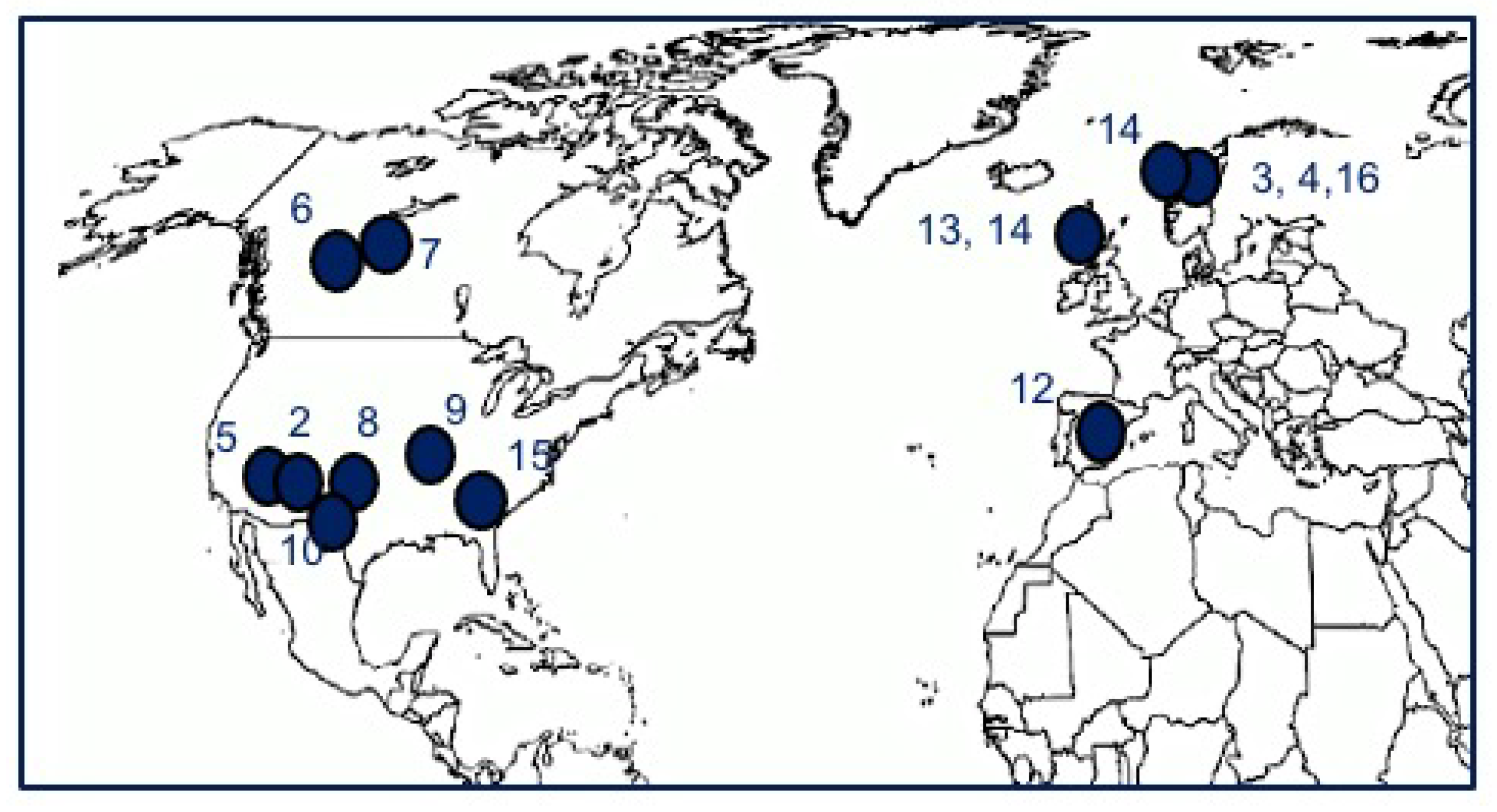
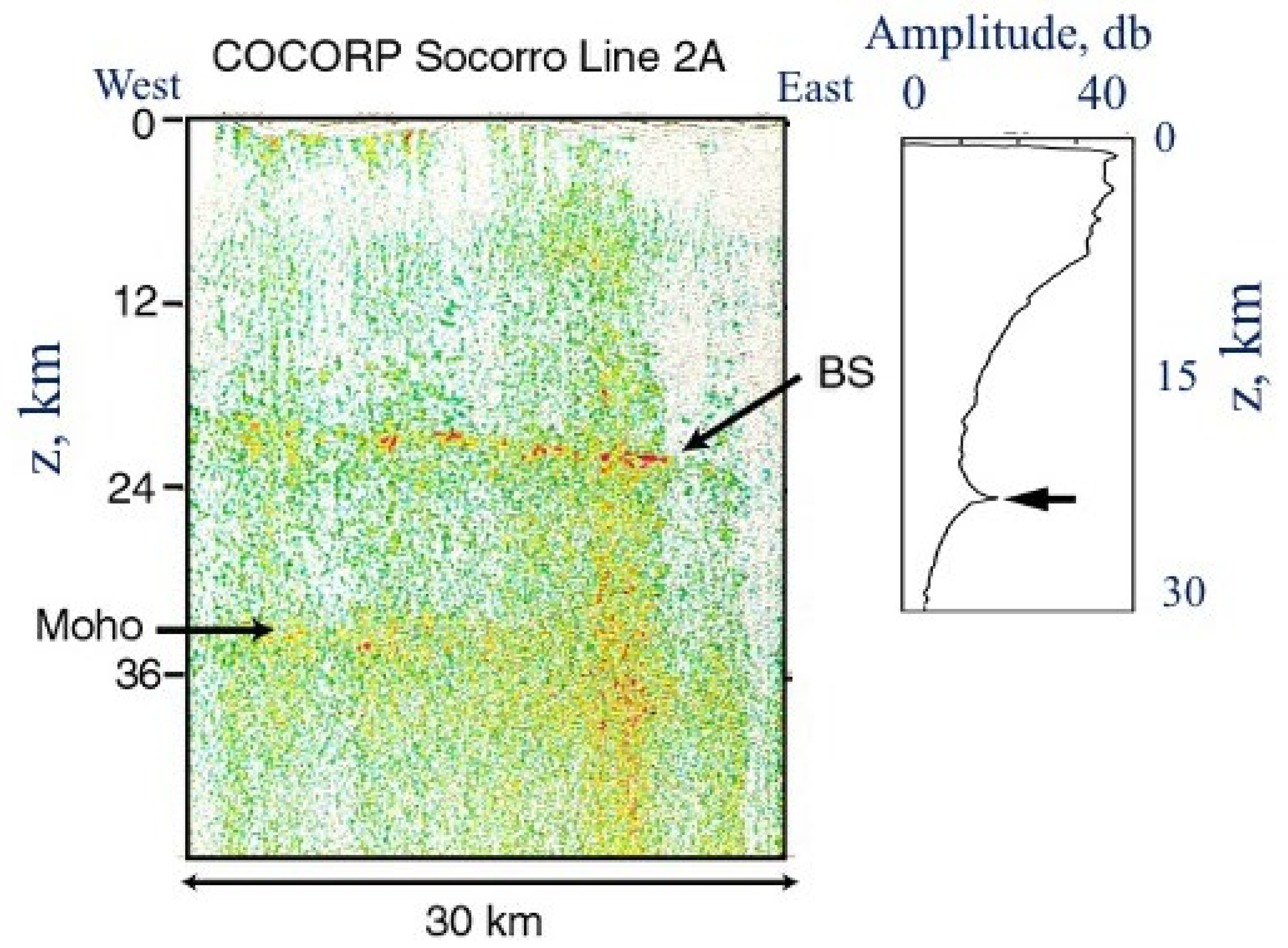

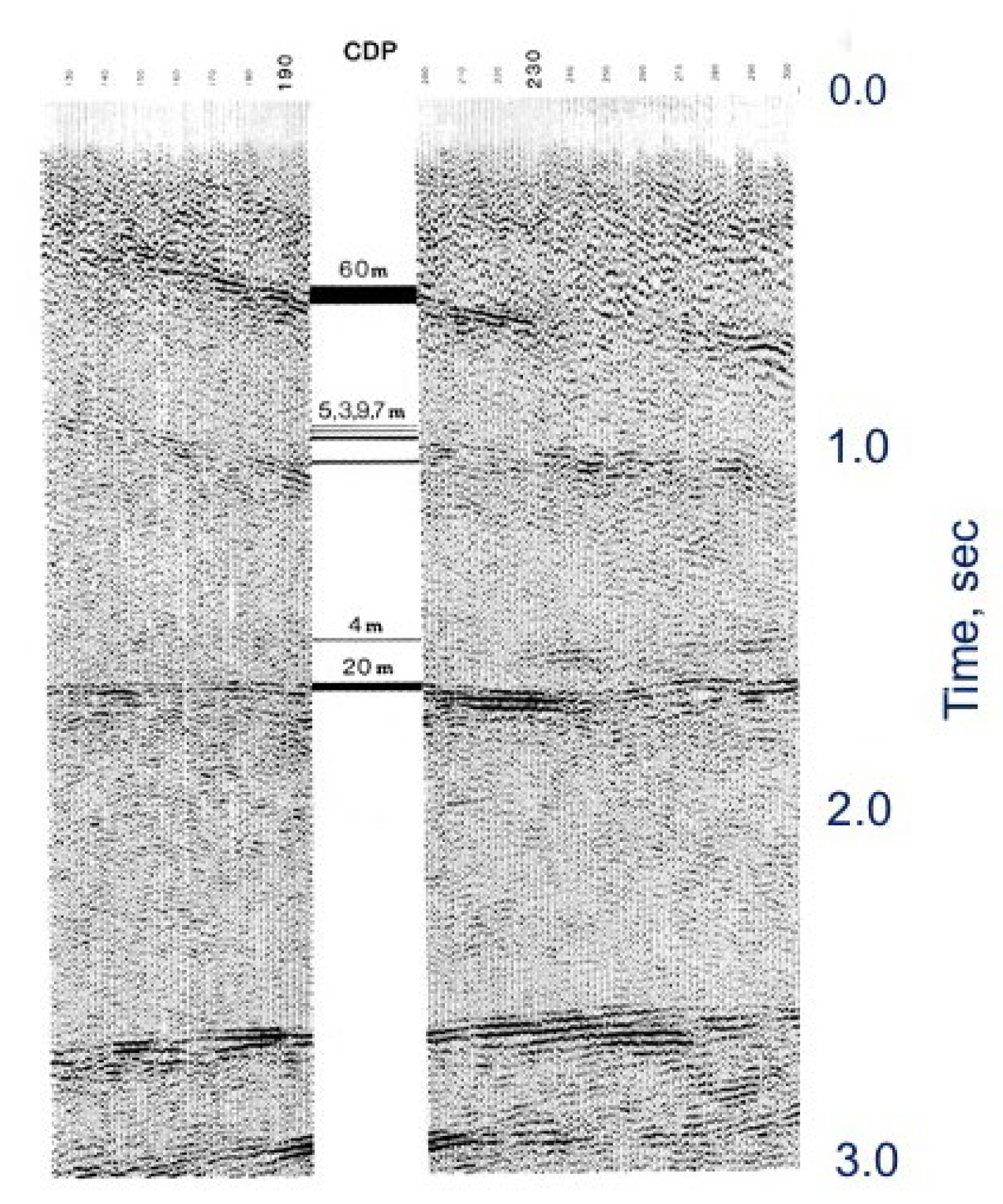
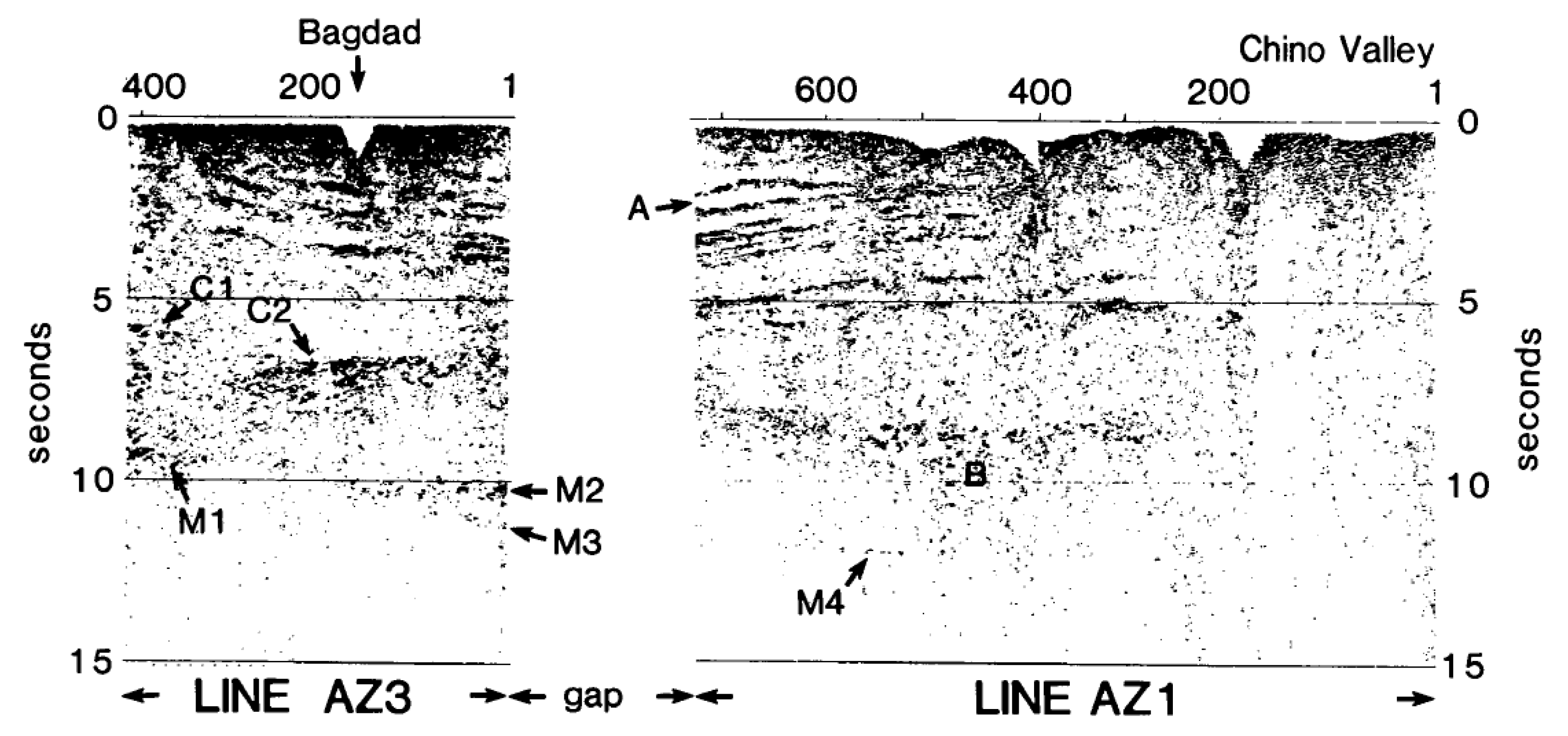
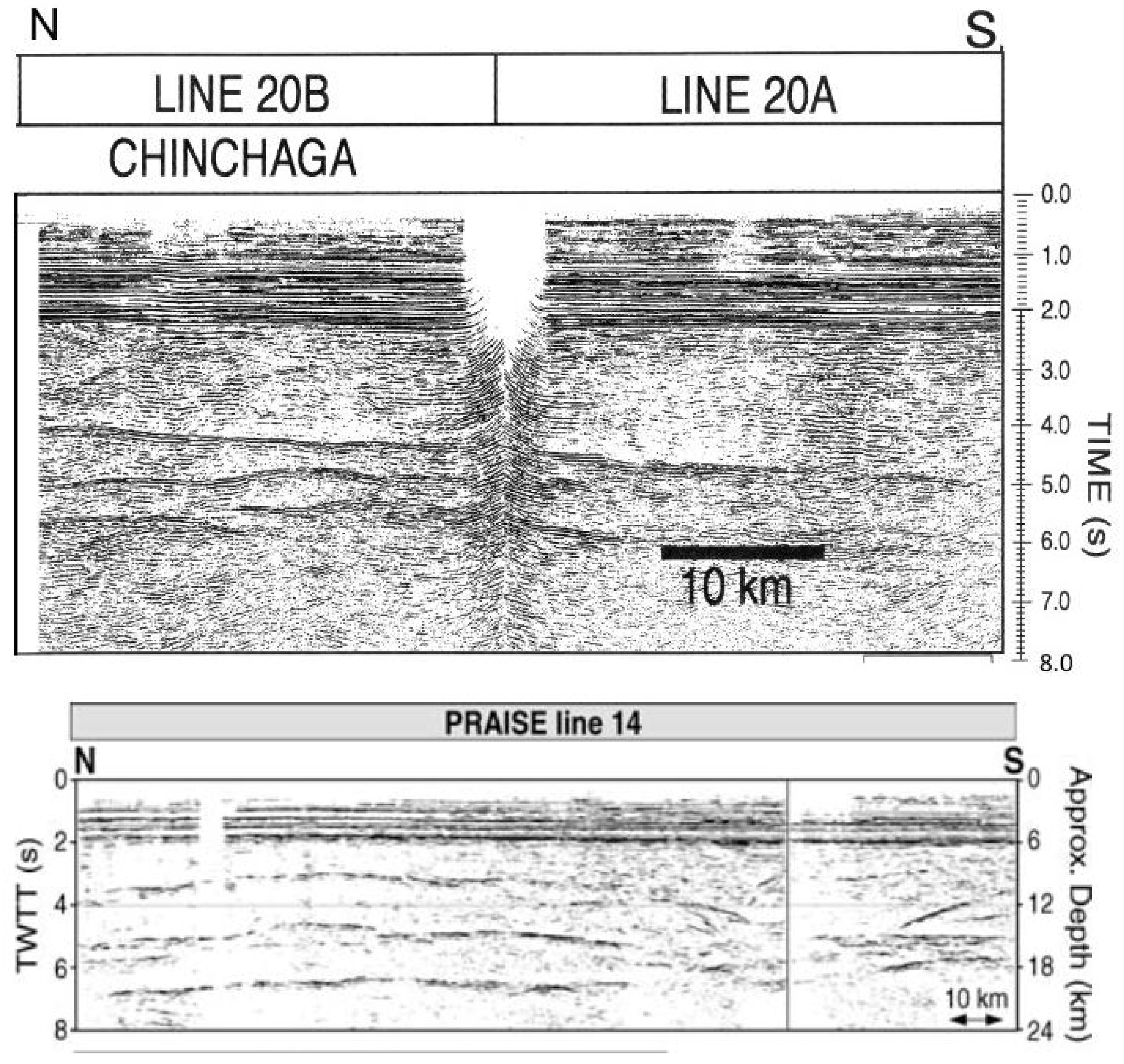

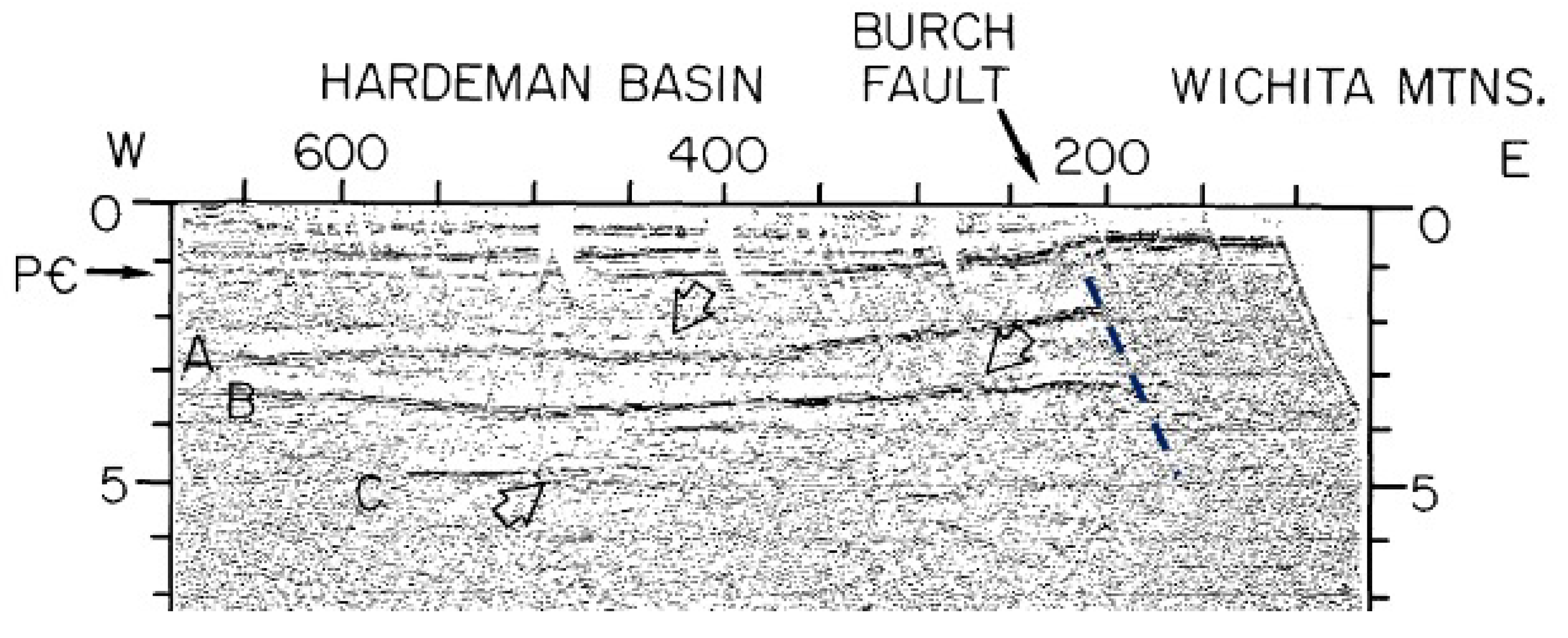

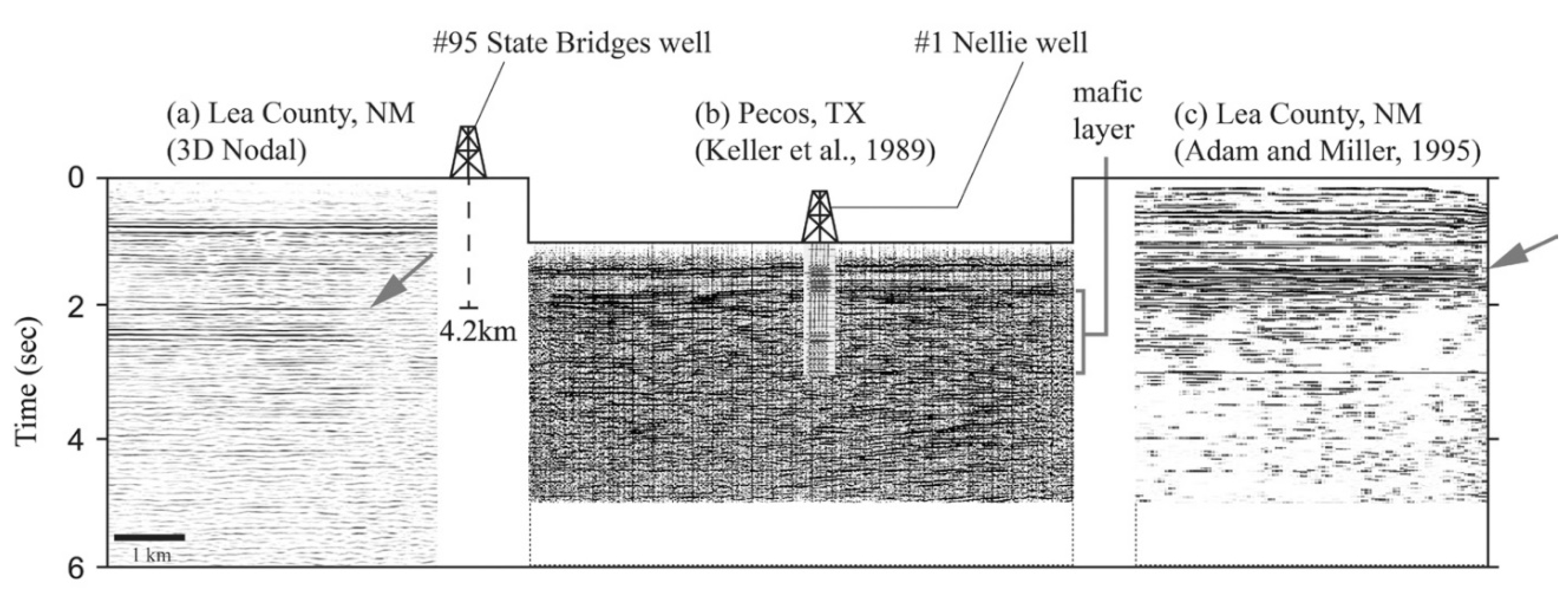
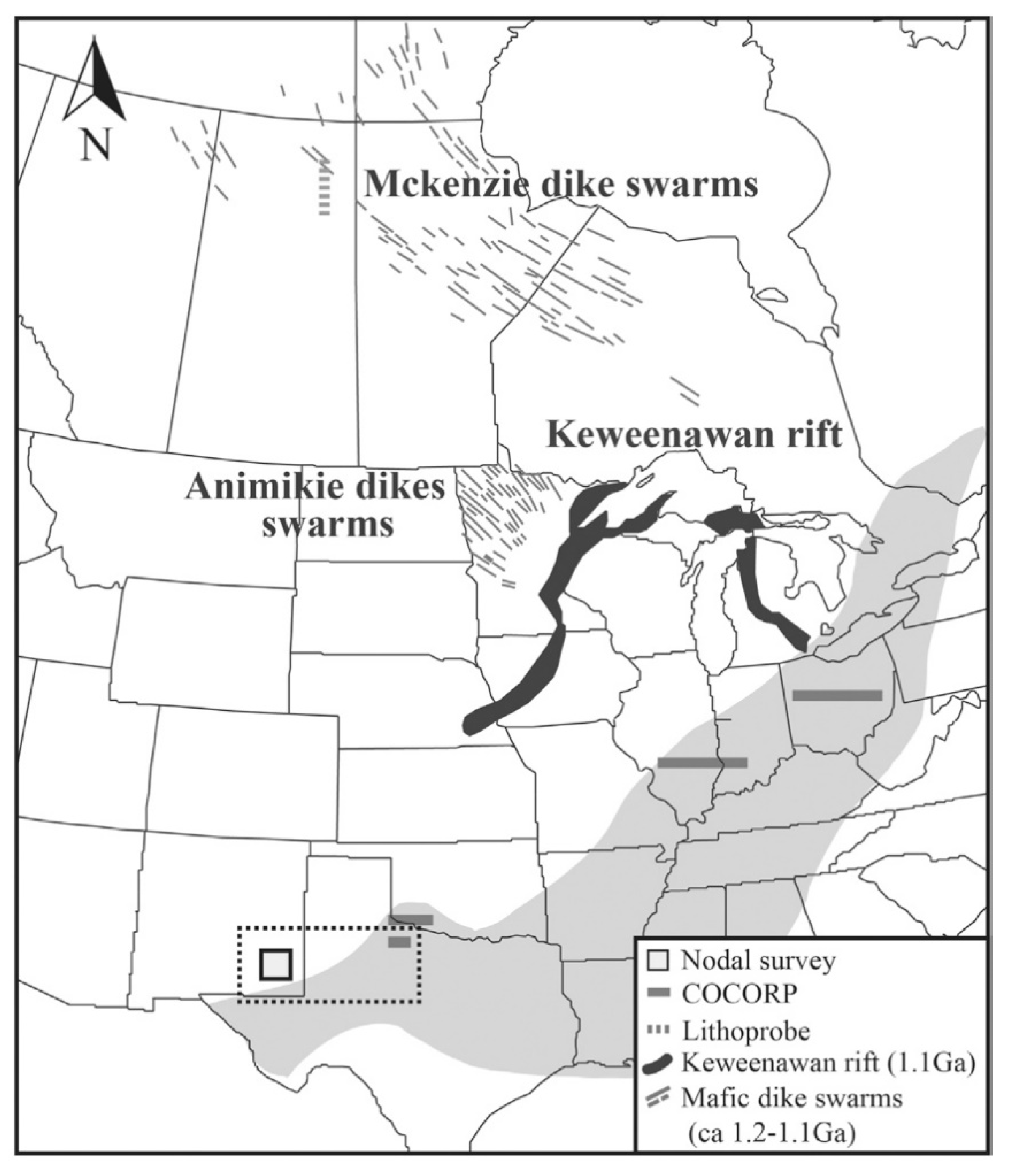




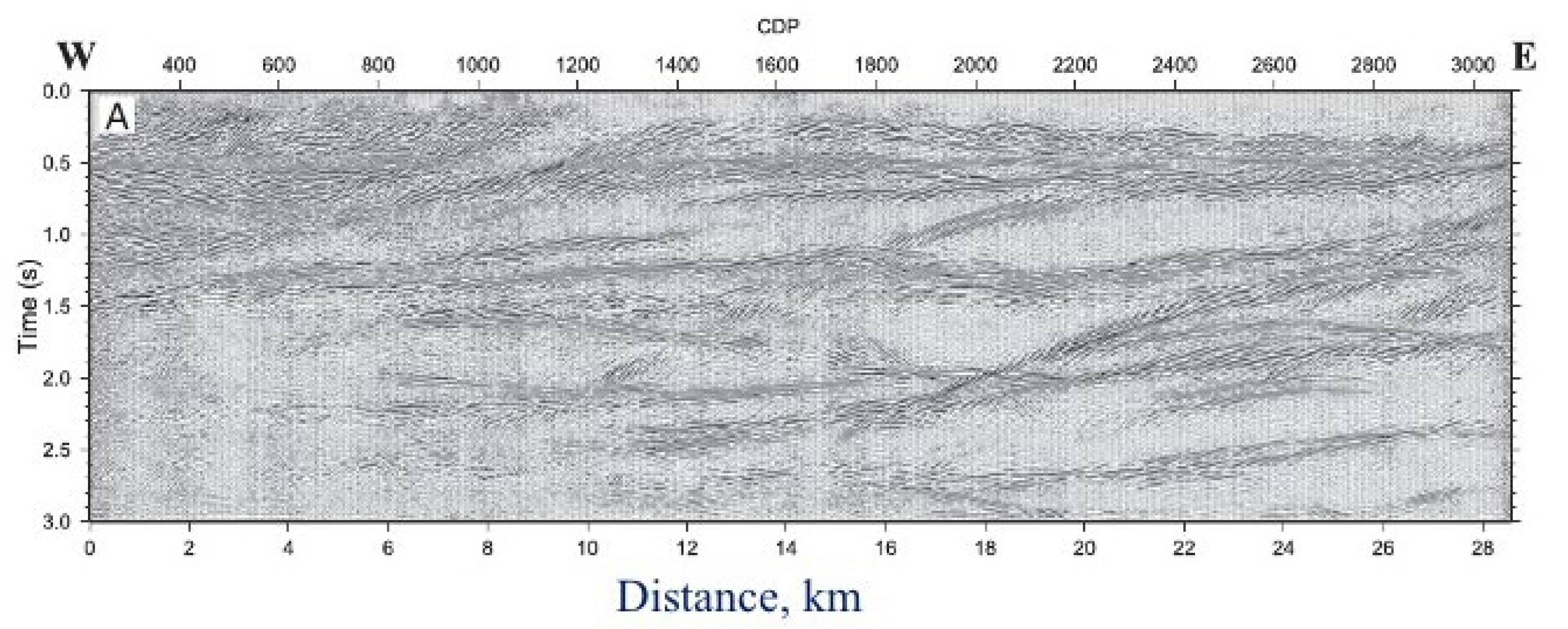
| Material | Vp (km/s) @ 200 Mpa | Density, kg/m3 | RC % against UCC | Source |
|---|---|---|---|---|
| granite-granodiorite | 6.246 | 2.76 | 0.3 | [30,31] |
| diabase | 6.712 | 2.87 | 9.3 | [30,31] |
| andesitic magma | 2.5 | 2.45 | −46.3 | [32] Mt. Hood andesite |
| basaltic magma | 6.243 | 2.76 | −30.6 | [32] Columbia River Basalt |
| Phyllite | 6.243 | 2.76 | 0,7 | [30,31] |
| Average upper continental crust (UCC) | 6.2 | 2.76 | 0.0 | [31,32,33] |
Publisher’s Note: MDPI stays neutral with regard to jurisdictional claims in published maps and institutional affiliations. |
© 2020 by the authors. Licensee MDPI, Basel, Switzerland. This article is an open access article distributed under the terms and conditions of the Creative Commons Attribution (CC BY) license (http://creativecommons.org/licenses/by/4.0/).
Share and Cite
Brown, L.D.; Kim, D. Extensive Sills in the Continental Basement from Deep Seismic Reflection Profiling. Geosciences 2020, 10, 449. https://doi.org/10.3390/geosciences10110449
Brown LD, Kim D. Extensive Sills in the Continental Basement from Deep Seismic Reflection Profiling. Geosciences. 2020; 10(11):449. https://doi.org/10.3390/geosciences10110449
Chicago/Turabian StyleBrown, Larry D., and Doyeon Kim. 2020. "Extensive Sills in the Continental Basement from Deep Seismic Reflection Profiling" Geosciences 10, no. 11: 449. https://doi.org/10.3390/geosciences10110449
APA StyleBrown, L. D., & Kim, D. (2020). Extensive Sills in the Continental Basement from Deep Seismic Reflection Profiling. Geosciences, 10(11), 449. https://doi.org/10.3390/geosciences10110449






